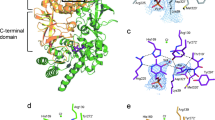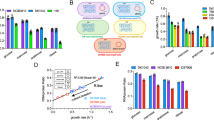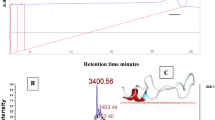Abstract
The ability to synthesize D-alanine is essential for the biosynthesis of cell walls of most bacteria. D-alanine is normally produced by racemization of L-alanine; in the absence of a functional alanine racemase, D-alanine must be provided for cell growth. An alanine racemase gene has been isolated from Bacillus subtilis. When this gene is placed on a multicopy plasmid in B. subtilis it can complement a chromosomal deletion of the alanine racemase gene. The presence of the alanine racemase gene on a plasmid provides strong selective pressure for maintenance of the plasmid in a strain lacking a functional alanine racemase. This selective pressure can be used instead of antibiotics to maintain plasmids in B. subtilis.
This is a preview of subscription content, access via your institution
Access options
Subscribe to this journal
Receive 12 print issues and online access
$259.00 per year
only $21.58 per issue
Buy this article
- Purchase on SpringerLink
- Instant access to full article PDF
Prices may be subject to local taxes which are calculated during checkout
Similar content being viewed by others
References
Ferrari, E. and Hoch, J.A. 1983. A single copy transducible system for complementation and dominance analysis in Bacillus subtilis. Molec. Gen. Genet. 189: 321–325.
Chang, S., Ho, D., Gray, O., Chang, S.-Y. and McLaughlin, J. 1983. Functional expression of human interferon genes and construction of a partition proficient plasmid vector in B. subtilis, pp 227–231. In: Genetics of Industrial Microorganisms. Y. Ikeda and T. Beppu (eds.) Kodansha Ltd, Tokyo, Japan.
Tanaka, T. and Sakaguchi, K. 1978. Construction of a recombinant plasmid composed of B. subtilis leucine genes and a B. subtilis (natto). plasmid: Its use as cloning vehicle in B. subtilis 168. Mol. Gen. Genet. 165: 269–276.
Mandelstam, J., McQuillen, K. and Dawes, I. 1982. Biochemistry of Bacterial Growth, 3rd edition, p. 57. John Wiley and Sons, New York.
Berberich, B., Kaback, M. and Freese, E. 1968. D-amino acids as inducers of L-alanine dehydrogenase in Bacillus subtilis. J. Biol. Chem. 243: 1006–1011.
Buxton, R.S. and Ward, J.B. 1980. Heat-sensitive lysis mutants of Bacillus subtilis 168 blocked at three different stages of peptidiglycan synthesis. J. Gen. Microbiol. 120: 283–293.
Lund, T., Grosveld, F.G. and Flavell, R.A. 1982. Isolation of transforming DNA by cosmid rescue. Proc. Natl. Acad. Sci. USA. 79: 520–524.
Youngman, P., Perkins, J.B. and Losick, R. 1984. A novel method for rapid cloning in Escherichia coli of Bacillus subtilis chromosomal DNA adjacent to Tn917 insertions. Mol. Gen. Genet. 195: 424–433.
Yang, M.Y., Ferrari, E. and Henner, D.J. 1984. Cloning of the neutral protease gene of Bacillus subtilis and the use of the cloned gene to create an in vitro-derived deletion mutation. J. Bacteriol. 160: 15–21.
Band, L. and Henner, D.J. 1984. Bacillus subtilis requires a “stringent” Shine-Dalgarno region for gene expression. DNA 3: 17–21.
Murray, C.L. and Rabinowitz, J.C. 1982. Nucleotide sequences of transcription and translation initiation regions in Bacillus phage φ29 early genes. J. Biol. Chem. 257: 1053–1062.
Wasserman, S.A., Daub, E., Grisafi, P., Botstein, D. and Walsh, C.T. 1984. Catabolic alanine racemase from Salmonella typhimurium DNA sequence, enzyme purification and characterization. Biochem. 23: 5182–5187.
Wasserman, S.A., Walsh, C.T. and Botstein, D. 1983. Two alanine racemase genes in Salmonella typhimurium that differ in structure and function. J. Bacteriol. 153: 1439–1450.
Wild, J., Hennig, J., Lobocka, M., Walczak, W. and Klopotowski, T. 1985. Identification of the dadX gene coding for the predominant isoenzyme of alanine racemase in Escherichia coli K-12. Molec. Gen. Genet. 198: 315–322.
Freese, E., Park, S.W. and Cashel, M. . 1964. The developmental significance of alanine-dehydrogenase in Bacillus subtilis. Proc. Natl. Acad. Sci. U.S.A. 51: 1164–1172.
Dagert, M. and Ehrlich, S.D. 1979. Prolonged incubation in calcium chloride improves the competence of Escherichia coli cells. Gene 6: 23–28.
Anagnostopoulos, C. and Spizizen, J. 1961. Requirements for transformation in Bacillus subtilis. J. Bacteriol. 81: 741–746.
Hoch, J.A., Barat, M. and Anagnostopoulos, C. 1967. Transformation and transduction in recombination-defective mutants of Bacillus subtilis. J. Bacteriol. 93: 1925–1937.
Ferrari, F.A., Nguyen, A., Lang, D. and Hoch, J.A. 1983. Construction and properties of an integrable plasmid for Bacillus subtilis. J. Bacteriol. 154: 1513–1514.
Birnboim, H.C. and Doly, J. 1979. A rapid alkaline extraction procedure for screening recombinant plasmid DNA. Nucleic Acids Res. 7: 1513–1523.
Marmur, J. 1961. A procedure for the isolation of deoxyribonucleic acid from microorganisms. J. Mol. Biol. 3: 208–218.
Lawn, R.M., Adelman, J., Bock, S.C., Franke, A.E., Houck, C.M., Najarian, R.C., Seeburg, P.H. and Wion, K.L. 1981. The sequence of human serum albumin cDNA and its expression in E. coli. Nucleic Acids Res. 9: 6103–6114.
Wahl, G.M., Stern, M. and Stark, G.R. 1979. Efficient transfer of large DNA fragments from agarose gels to diazobenzyloxy-methyl-paper and rapid hybridization by using dextran sulfate. Proc. Natl. Acad. Sci. USA. 76: 3683–3687.
Southern, E.M. 1975. Detection of specific sequences among DNA fragments separated by gel electrophoresis. J. Mol. Biol. 98: 503–517.
Rigby, P.W.J., Dieckmann, M., Rhodes, C. and Berg, P. 1977. Labeling deoxyribonucleic acid to high specific activity in vitro by nick translation with DNA polymerase I. J. Mol. Biol. 113: 237–251.
Maniatis, T., Jeffrey, A. and Kleid, D.G. 1975. Nucleotide sequence of the rightward operator of phage λ. Proc. Natl. Acad. Sci. USA 72: 1184–1188.
Messing, J. and Vieira, J. 1982. A new pair of M13 vectors for selecting either DNA strand of double-digest restriction fragments. Gene 19: 269–276.
Sanger, F., Nicklen, S. and Coulson, A.R. 1977. DNA sequencing with chain terminating inhibitors. Proc. Natl. Acad. Sci. USA 74: 5463–5467.
Author information
Authors and Affiliations
Rights and permissions
About this article
Cite this article
Ferrari, E., Henner, D. & Yang, M. Isolation of an Alanine Racemase Gene from Bacillus subtilis and its Use for Plasmid Maintenance in B. subtilis. Nat Biotechnol 3, 1003–1007 (1985). https://doi.org/10.1038/nbt1185-1003
Received:
Accepted:
Issue date:
DOI: https://doi.org/10.1038/nbt1185-1003
This article is cited by
-
Investigating the genetic regulation of the ECF sigma factor σS in Staphylococcus aureus
BMC Microbiology (2014)



